As an Amazon Associate, I earn from qualifying purchases.
Follow this step-by-step tutorial to learn how to can green beans in a pressure canner safely. One of the easiest canning recipes around, you’ll love having jars of home-canned green beans to use all year long.
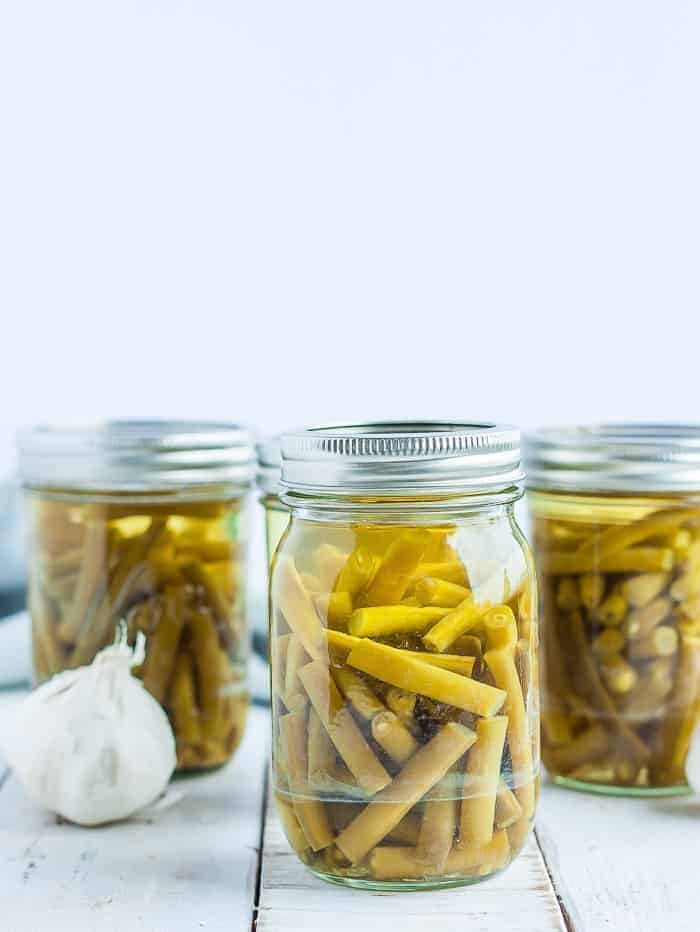
Summer means gorgeous and abundant fresh produce! While fresh green beans are incredible, learning to pressure-can green beans allows you to enjoy them all year long.
Canning green beans is a straightforward process. Let me hold your hand and walk you through it.
Just a heads up, you cannot safely can green beans in a water bath canner.
Green beans, and all low-acid vegetables (like when canning beets, canning potatoes, or canning carrots) must be preserved using a pressure canner.
The good news is that pressure-canning green beans is very straightforward and easy to do.
How to Can Green Beans
*I’ll walk you through it here with some photos and tips, and you’ll also find a printable recipe card at the bottom of the post with exact measurements, etc. You can also click “jump to recipe” to skip down.
Start with green bean pods that are tender and full but not overly mature. You don’t want to be able to see the beans bulging through the pod; those will produce tough and unappetizing canned green beans.
An average of 14 pounds is needed per canner load of 7 quarts; an average of 9 pounds is needed per canner load of 9 pints. A bushel weighs 30 pounds and yields 12 to 20 quarts – an average of 2 pounds per quart. (source)
If you don’t have a large batch of beans to can at once, you can process just a few jars if needed. It eventually does add up over the season!
Rinse the beans in cool water, discarding any overly mature pods. Next, you’re going to “snap” the beans to remove the ends and strings. You can do this by hand, or using a knife. Pro tip: the knife method is generally faster, but I have noticed that the cut ends will brown in the jars a few months after canning. They’re still safe to eat but keep it in mind if the final appearance is important to you.
You can leave the de-stringed beans whole or cut them into 1-inch pieces. The size usually depends on how you want to use them once they are canned.
Wash and clean your jars. It is no longer necessary to sterilize jars before canning (hurray!) but you should make sure they are preheated enough to not crack when placed in hot water.
You can put them in a clean dishwasher and run them through a quick wash cycle, or place them in a large pan with some water in a low-heat oven (my oven’s lowest temp is 170˚F) until you need them. I’ve even just put hot tap water in them before and left them on the counter.
Wash your lids with hot soapy water and place them in a clean bowl for now.
If you are doing the hot pack method (see below), add the green beans to a pot of boiling water and let them cook for 5 minutes. If you are doing the raw pack method, allow 8 (ish) cups of water to come to a boil in a pot or kettle.
Add 3 quarts of water to your pressure canner and put it on a burner set to high. Make sure there is a canning rack in the bottom of the canner.
If you are using salt, add 1/2 tsp canning salt to pints and 1 tsp to quarts. Fill jars with green beans. You really want to pack them in there. Pro tip: wiggle and gently tap the bottom of the jar against the counter often as you add them to allow them to settle and make room for more.
Using a canning funnel, carefully and slowly add the clean boiling water, leaving 1 inch of headspace.
Using a long utensil (I prefer a plastic chopstick), remove air bubbles from the jar.
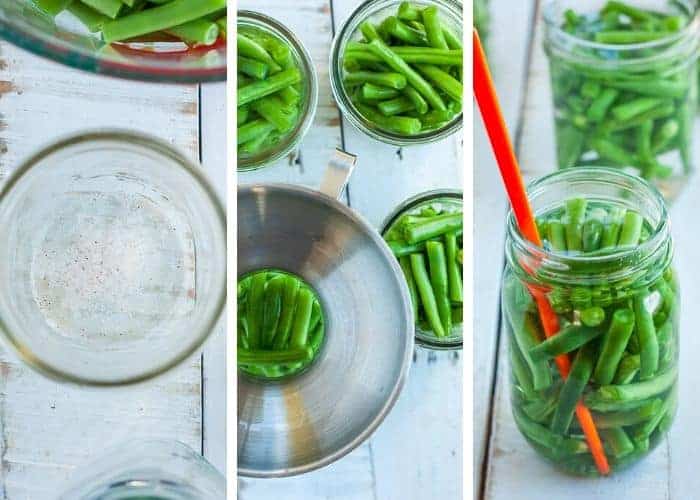
Clean the rim of the jar very well with a hot damp rag. Any food debris left on the rim may impact the seal of the lid in the canner.
Place a clean lid on the jar. Add a ring, and tighten it to fingertip tight.
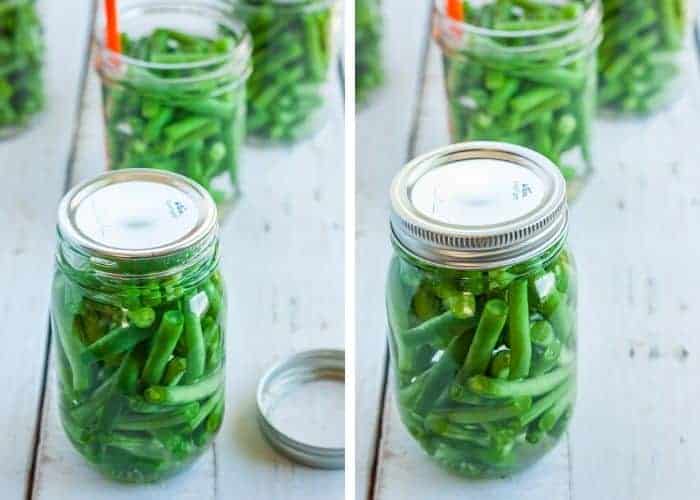
Using canning tongs, gently place the jars in the canner. Lock the lid. Soon, steam will start coming through the vent pipe (I call it the steam chimney). Allow the steam to pass through for about 10 minutes. Then put the pressure regulator (I call it the chimney cap) on top. (see the 4 photo grid below for a visual of this process step by step)
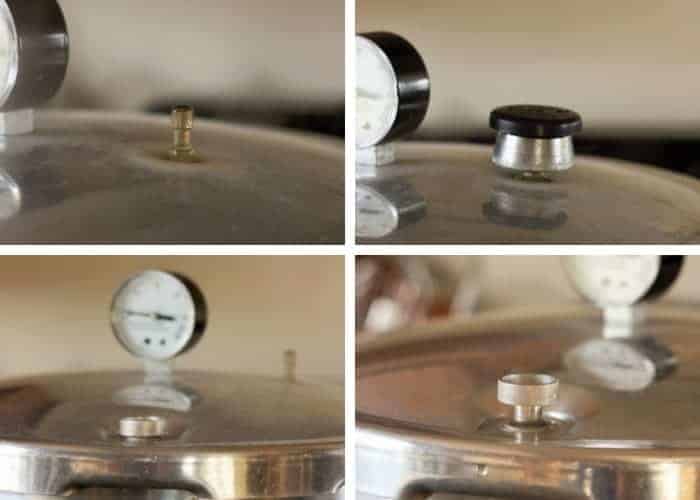
Pretty soon, the air vent will pop up. That is a sign that you’re starting to build pressure inside the canner (get excited. This is happening!). Processing times will vary based on altitude. See the charts below.
Pressure Canning Green Beans in a Dial-Gauge Pressure Canner
| Canner Pressure (PSI) at Altitudes of | ||||||
| Style of Pack | Jar Size | Processing Time | 0-2,000 ft | 2,001-4,000 ft | 4,001-6,000 ft | 6,001-8,000 ft |
| Hot | Pints | 20 min | 11 lbs | 12 lbs | 13 lbs | 14 lbs |
| Quarts | 25 min | 11 lbs | 12 lbs | 13 lbs | 14 lbs | |
| *Source: National Center For Home Food Preservation | ||||||
Processing Time for Green Beans in a Weighted-Gauge Pressure Canner
| Canner Pressure (PSI) at Altitudes of: | ||||
| Style of Pack | Jar Size | Processing Time | 0-1,000 ft | Above 1,001 ft |
| Hot | Pints | 20 min | 10 lb | 15 lb |
| Quarts | 25 min | 10 lb | 15 lb | |
| *Source: National Center For Home Food Preservation | ||||
When the dial gauge reaches the appropriate PSI, reduce the burner temp to medium, and start your timer. The pressure must stay at the PSA or (a little bit) above for the duration of the cooking time. You’ll likely need to adjust the temp on the burner a few times depending on your stove.
When the time is up, remove the canner from the burner and allow it to sit until you hear a distinctive “click” of the air vent dropping. Remove the pressure regulator and carefully remove the lid of the canner (Pro tip: I always use oven mitts when I take the lid off because the steam is super hot).
Let the jars sit for 5 minutes in the canner with the lid off and then lift them out with canning tongs. Pro tip: allowing the jars to sit in the canner with the lid off can help reduce the siphoning of liquid in your jars.
Place hot jars on a towel where they can sit undisturbed for 12 hours.
After a few hours, to check for sealing, gently press down in the middle of the lid. If the lid has no give, it’s sealed. If you can press the lid in and it pops a bit, your jars are not sealed.
RAW PACK FOR CANNING Green Beans
Raw packing (also known as cold pack or cold packing) simply means placing the beans in the jars without precooking them, filling the jars with clean boiling water, and then pressure canning them.
Raw packing is much faster than a hot pack process, but there are some drawbacks. No matter how well you pack the jars, the density of the veggies will change during their time in the canner.
This often leads to something called “fruit float” in which the produce will float to the top of the jar, leaving water on the bottom. You’ll find this when you’re canning peaches as well. There is nothing wrong with fruit float as long as your jars are still sealed.
HOT PACK FOR CANNING Green Beans
Hot packing involves cooking the green beans in boiling water for 5 minutes before packing them into jars for canning.
The appeal of hot packing is that you typically can fit more per jar, and the near elimination of fruit float. The drawback is that I find it makes the beans too mushy for my taste. But you do you, boo.
Pro Tips/Recipe Notes
- The beans will change from a gorgeous bright green to a dull boring green once canned. This is normal, and they’re still safe to eat.
- Siphoning is when liquid seeps out from under the lids and reduces the overall amount of liquid in the jar. If just a bit of siphoning has happened and your jars sealed, your item is still safe to eat, but use your best judgment. I tend to quickly use any jar that has experienced siphoning simply because it can discolor the food at the top not covered in the liquid.
- Pressure canners can often leave white lines on lids, rings, and jars (you’ll see it on my jars in the photo at the top of the post). It’s totally normal and safe. To prevent this, add 1/3 cup of white vinegar to the canner before processing. I just forgot to do it in this instance. 🙂
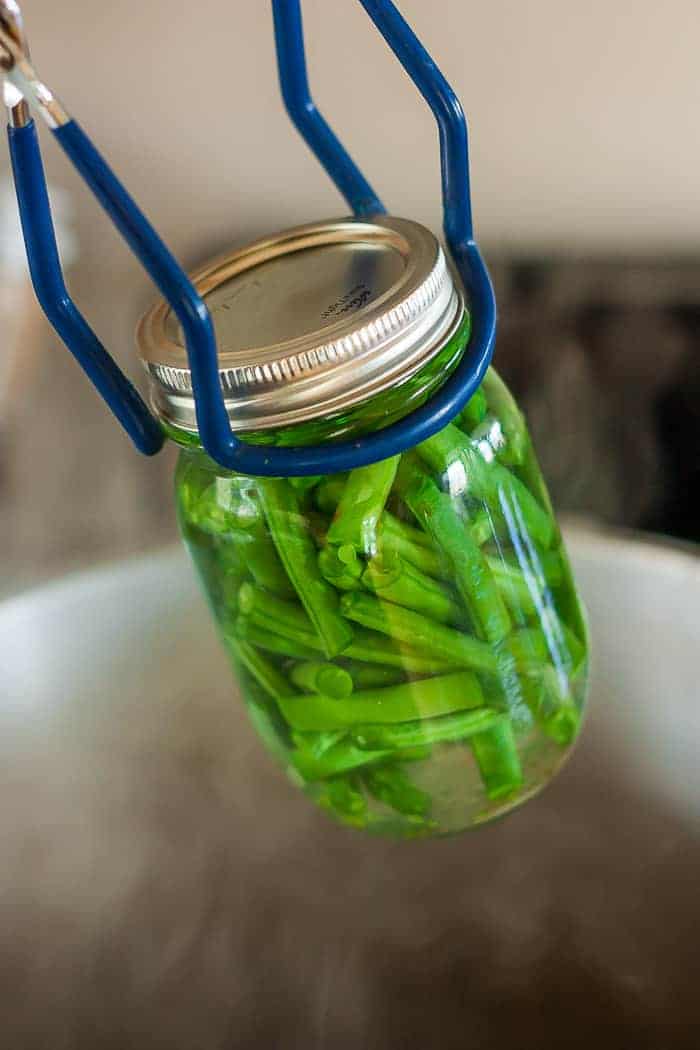
Canning Fresh Green Beans (Hot or Raw Pack Options)
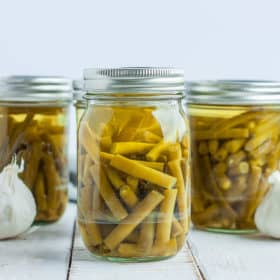
Ingredients
- 9 lbs green beans
- 8 cups water {for jars}
- 3 quarts water {for canner}
- 4.5 tsp canning salt {optional}
Instructions
- Wash and clean your jars. Make sure they are preheated enough to not crack when placed in hot water.
- Wash your lids with hot soapy water and place them in a clean bowl.
- Snap or cut beans to remove any strings, and cut into 1-inch pieces. Note: once the string has been removed, you may also leave them whole if you prefer.9 lbs green beans
- (HOT PACK & COLD PACK INSTRUCTIONS) If you are hot packing, add the beans to a pot of boiling water and let them cook for 5 minutes. If you are not hot packing, allow 8 (ish) cups of water to come to a boil in a pot or kettle.8 cups water
- Add 3 quarts of water to the pressure canner and put it on a burner set to high. Make sure there is a canning rack in the bottom of the canner.3 quarts water
- Add the beans to the jars. If adding salt, do that now. Tap the jar a few times to pack them in there as well as possible.4.5 tsp canning salt
- Using a canning funnel, carefully and slowly add the clean boiling water from the kettle/pot, leaving 1-inch of headspace. Headspace is the distance between the top of the food and the top of the jar.
- Using a long utensil (I prefer a plastic chopstick), remove air bubbles from the jar.
- Clean the rim of the jar very well with a hot damp rag. Any food debris left on the rim may impact the seal of the lid in the canner.
- Place a clean lid on the jar. Add a ring, and tighten to fingertip tight.
- Using canning tongs, gently place the jars in the canner.
- Lock the lid. Soon, steam will start coming through the vent pipe. Allow the steam to pass through for about 10 minutes. Then put the pressure regulator on top.
- Pretty soon, the air vent will pop up.
- In a dial-gauge pressure canner, process pints and quarts based on the elevation guide below (see processing chart in post for altitude adjustments):*0-2,000f ft {PSI: 11 lbs of pressure} = Pints 20 min, Quarts 25 min*2,001-4,000k ft {PSI: 12 lbs of pressure} = Pints 20 min, Quarts 25 min*4,001-6,000k ft {PSI: 13 lbs of pressure} = Pints 20 min, Quarts 25 min*6,001-8,000k {PSI: 14 lbs of pressure} = Pints 20 min, Quarts 25 min
- When the dial gauge reaches the appropriate PSI, reduce the burner temp to medium, and start your timer. The pressure must stay at the PSI or (a little bit) above for the duration of the cooking time. You’ll likely need to adjust the temp on the burner a few times depending on your stove.
- When the time is up, remove the canner from the burner and allow it to sit until you hear a distinctive “click” of the air vent dropping. Remove the pressure regulator and carefully remove the lid of the canner (Pro tip: I always use oven mitts when I take the lid off because the steam is super hot).
- Let the jars sit for 5 minutes in the canner and then lift them out with canning tongs. Pro tip: allowing the jars to sit in the canner with the lid off can help reduce the siphoning of liquid in your jars.
- Remove with canning tongs and place on a towel where they can sit undisturbed for 12 hours.
- After a few hours, to check for sealing, gently press down in the middle of the lid. If the lid has no give, it’s sealed. If you can press the lid in and it pops a bit, your jars are not sealed.
Notes
Nutrition
Nutrition information is automatically calculated, so should only be used as an approximation.

Get my Canning e-book!
It’s 51 pages of every helpful tip and trick you could want as a brand new canner, AND it includes 13 ad-free canning recipes that are designed to take you from novice to pro.


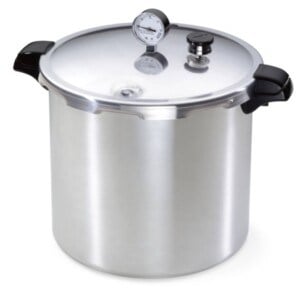
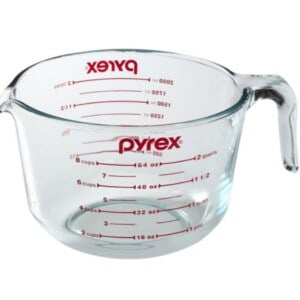
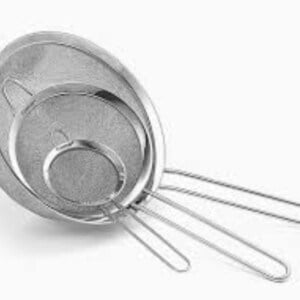
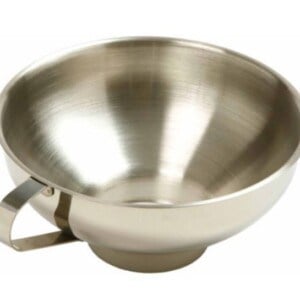
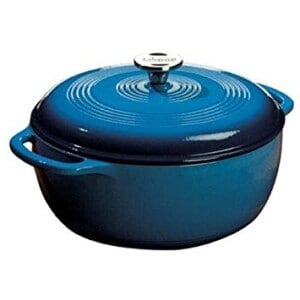
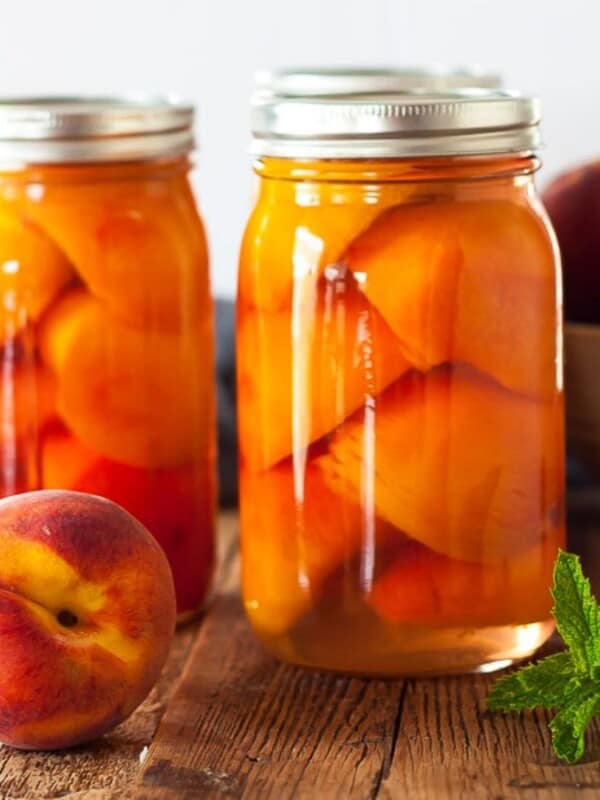
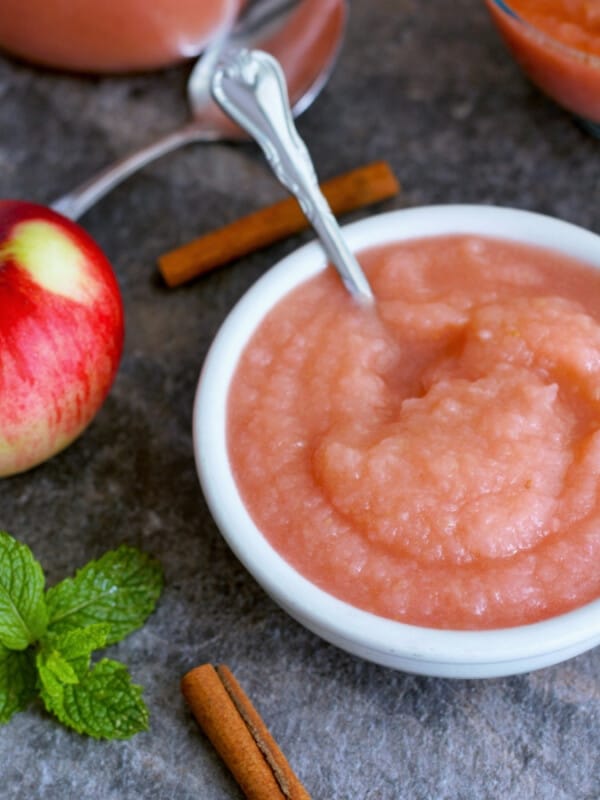
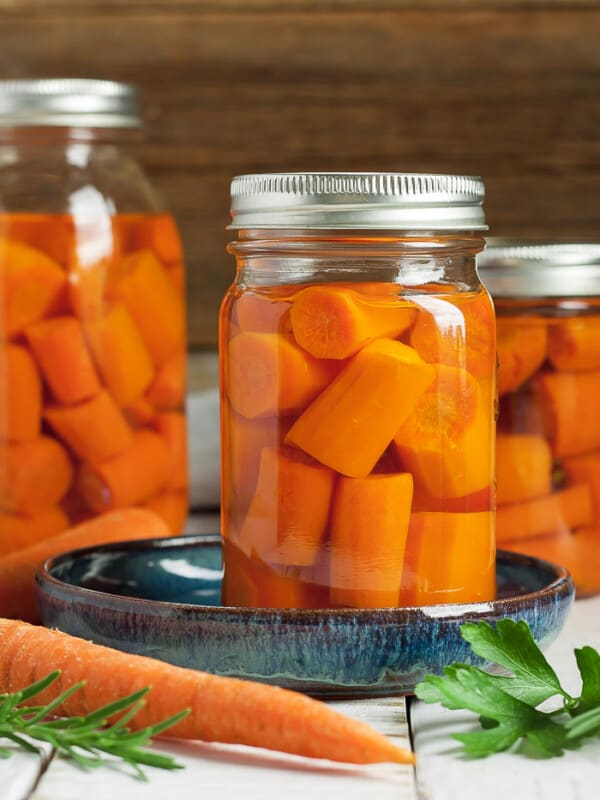
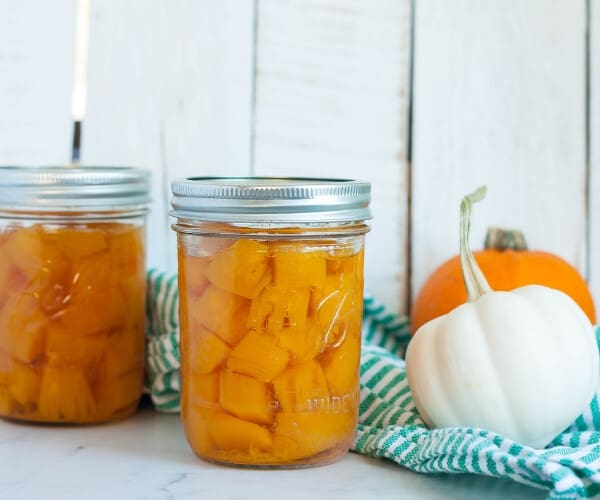
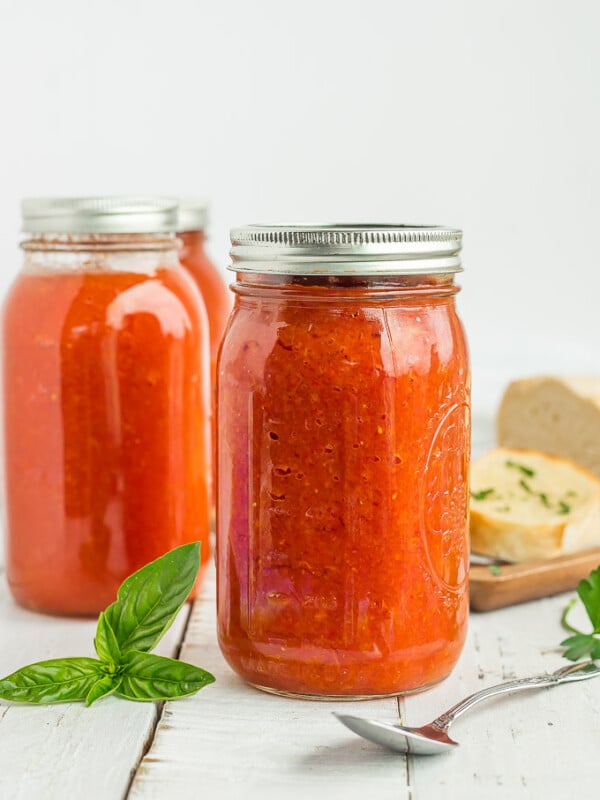
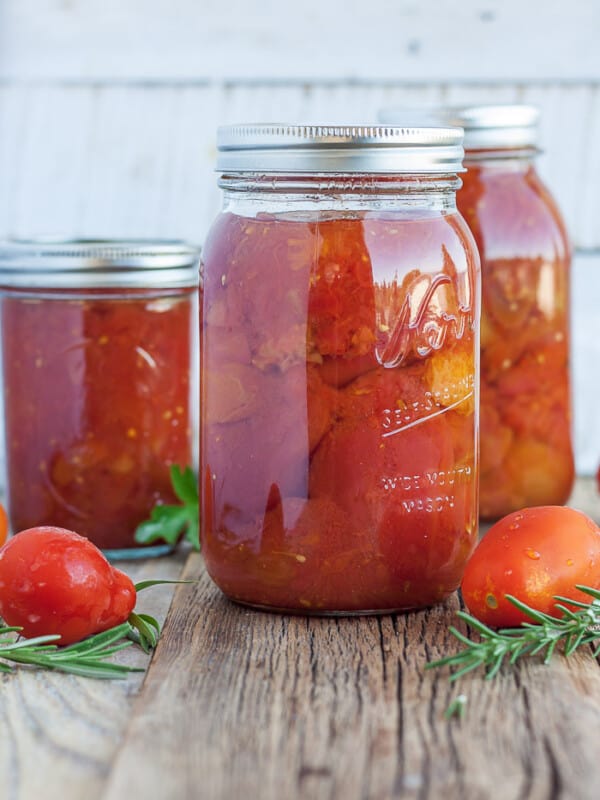






Can you ‘french’cut the green beans? Would there be any changes to note in doing so? Thank you!
Hi Jan, I don’t see why not.
That being said, it would reduce the surface area of the green bean, but you can’t reduce the processing time due to safety. My best guess is that doing so would likely result in a mushier final product.